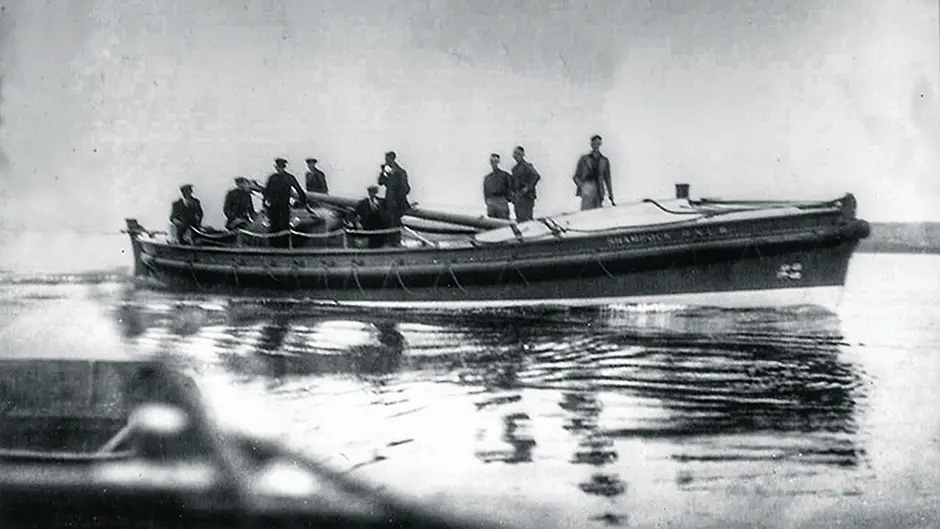The bravery and selflessness of Baltimore's Lifeboat crews over the past 10 decades are being honoured during this, their centenary year, as some of their more dramatic rescues are remembered.
BY NIAMH HAYES
BALTIMORE RNLI is celebrating its centenary this year during which time its lifeboats have launched an estimated 940 times, rescuing 867 people, and saving 280 lives.
The first RNLI lifeboat station in Ireland was established in Arklow, Co. Wicklow, in 1826. The station in Baltimore was built 89 years later, in 1915, at Bull Point at a cost of £2,765. Owing to World War I, the first lifeboat did not arrive until 1919. The boat had been launched as the Duke of Connacht, but because of the sentiment of the time after the Easter Rising, the name was changed to The Shamrock before its arrival in Baltimore on September 8th. The Shamrock remained in service until 1950 during which time she launched on service 43 times and rescued 34 lives.
The original remit for the crew was east as far as the Galley Head and over to Dursey Island to the west, but with the introduction of Castletownbere lifeboat in 1997, this remit changed and now the lifeboat serves as far as Mizen Head to the west.
Nowadays there are two boats operating out of Baltimore - the Tamar-Class All-Weather Lifeboat (ALB) Alan Massey and the Atlantic 85 Inshore Lifeboat (ILB) Rita Daphne Smyth. The original ILB was introduced in 2008 to complement the existing ALB. It covers the area from the Stag Rocks to Mizen Head.
The volunteer crew of Baltimore RNLI are trained on either the ALB, ILB or both. There is one full-time employee, Cathal Cottrell, who is the mechanic, and a large background team of volunteers who look after operations and fundraising.
Kieran Cotter is the coxswain of the ALB. He has been volunteering with Baltimore RNLI for 44 years. Originally from Cape Clear, Kieran’s family moved to Baltimore in 1970 and his father joined the crew of the lifeboat. He remained with them until 1981 when he died. In the meantime, Kieran joined in 1975 and in 1989 he became coxswain, a position which he still holds 30 years later.
Certain callouts stick out in Kieran’s memory. The St Gervais fishing vessel sank off the coast of Mizen Head in 2000. Four people lost their lives, two of whom were never recovered.
‘We received a call that a distress signal had gone off near Kinsale. The boat had left Castletownbere at midnight and we got the call a couple of hours later so I knew the location of the signal was impossible. I looked at the charts and saw that there could have been three major obstacles in the way of the boat, Sheep’s Head, Mizen Head and the Fastnet, so we went straight out to the line from here and worked backwards. As soon as we came around the Mizen that morning, I could smell the diesel in the water and I knew straight away that the boat had gone down,’ recalls Kieran.
Then there was the major drugs haul in 2007. The crew were called to assist the Castletownbere lifeboat in locating two people who were reportedly in the water. While they didn’t find anyone, they did find about 50 bales of what they thought was cannabis. A helicopter attempted to pick the bales out of the water but wasn’t successful.
‘We can pick things out of the water, we are trained to pick bodies out of the water, so we offered to help.
They asked us to bring the bales into Schull but I said we were going to Baltimore, it would be much more private there. The roads were closed off and officials with guns arrived. It was only back in Baltimore that we found out it was cocaine’, says Kieran.
2019 has been a quiet year so far, although there were four callouts during the last week of June, two to the local islands for a medical evacuation and two to boats that were in trouble.
Baltimore RNLI is always looking for volunteers. ‘One of the big problems here is that young people join but then move away for college or work. We also had a lot of commercial fishermen in the crew, but they are just not available anymore’, says Kieran.
‘People who come to live here, who move into the area and have no background in lifeboats, we have a lot of them training up’, adds Kieran. To join, you must be 17 and the training process takes between one and two years to complete.
As part of the 100th year celebration, the inshore lifeboat will be officially named on September 8th 2019, exactly 100 years after the The Shamrock arrived in Baltimore.
----
Bandon Co-Op is delighted to be involved with and supporting many local community groups all over West Cork. This video encapsulates some of the wonderful people that we have the pleasure of dealing with #TogetherStrongerWestCork









